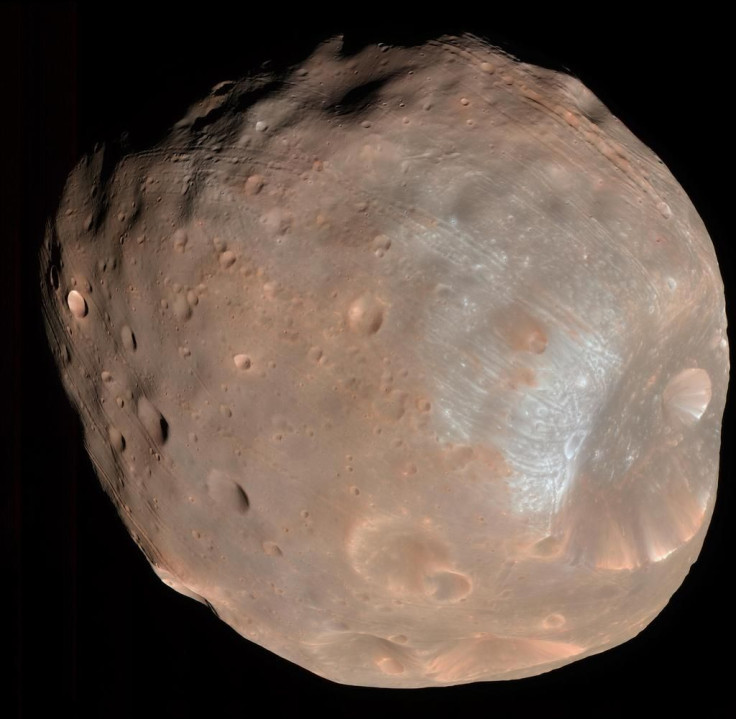Mars Moon Phobos Bids A Long, Slow Goodbye As It Faces Inevitable Destruction

Mars moon Phobos, named after the Greek god of fear, has had a difficult life of uncertain origin. The natural satellite may have been an asteroid captured in Mars' orbit or a chunk of the red planet ejected after a cosmic collision. Parentage aside, news comes of a death sentence placed on Phobos. Due to Mars' gravitational pull, Phobos will slowly break apart in the next 30 to 50 million years, according to NASA.
Phobos' impending doom is written on its scarred surface. The grooves running along Phobos are the result of the moon getting pulled apart by the gravitational pull of the Earth and Mars. The gravitational pull of the Earth and moon is responsible for the planet's tides as well as the bulging of both entities into a slight egg shape.
"We think that Phobos has already started to fail, and the first sign of this failure is the production of these grooves," Terry Hurford, a planetary scientist at NASA’s Goddard Space Flight Center, said in a statement. The research was presented Tuesday at the annual Meeting of the Division of Planetary Sciences of the American Astronomical Society.
Gravitational forces affect Phobos more than Earth's moon because of the former's close proximity to Mars. Instead of orbiting at a distance of around 238,000 miles -- the distance between the moon and Earth -- Phobos orbits at an incredibly close 3,700 miles from Mars. The irregularly shaped Phobos (approximately 12 miles in diameter) is also much smaller than the moon (2,159 miles in diameter). Phobos makes a complete trip around Mars three times in a Martian day.
Mars' tug on Phobos can be seen in the grooves on Phobos. The moon was previously believed to be solid, so the grooves were thought to be the traces of the impact that formed the large Stickney Crater. That theory was revised to ejected material raining down on the moon as a likely culprit. If Phobos is more like a giant rock cluster covered by regolith, a layer of powered rocky material, tidal forces have enough strength to pull Phobos apart.
Previous research based on data collected by the European Space Agency's Mars Express spacecraft revealed a low density for Phobos due to a "spongelike structure." The porous nature of Phobos helped the moon survive the impact that left behind the 6-mile-wide Stickney crater. Revising the model to a more porous Phobos led to similar stress grooves as currently seen on its surface.
Understanding what's happening to Phobos will provide researchers with new insights into similar events happening within the solar system and beyond. Neptune's moon Triton is facing its own demise, and scientists can use this new research to better understand exoplanets that can't be imaged.
Mars can take comfort in knowing that it'll still have Deimos after Phobos' demise.
© Copyright IBTimes 2024. All rights reserved.






















